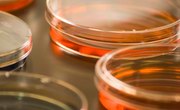
Microbiology is a particular branch of scientific study that focuses on microorganisms. This includes bacteria, unicellular organisms and often viruses.
Many terms within microbiology have been introduced into the common vernacular. While the use of these terms in everyday language isn't incorrect, there are often specific differences in those definitions when discussing them in relation to microbiology.
One of those terms is inoculation. Most people know the inoculate meaning as it relates to vaccines and healthcare. While this is correct, the inoculation definition for the study and practice of microbiology is more specific to introducing microorganisms into environments where they will grow and thrive.
Common Inoculation Definition
The common way we define inoculate is actually the immunological definition of the term. In immunology, inoculation refers to introducing an antigenic substance (aka antigens that induce an immune response) or a vaccine (weakened/dead/unactivated germs/pathogens) into the body in order to induce immunity to that substance/pathogen.
When these antigenic substances are introduced into your system via inoculation, you immune system creates antibodies against these components. This means that if you are introduced to the actual active/alive pathogen, you'll already have defenses in place to fight it off.
Some of the most common vaccinations are those for measles and mumps that most babies receive soon after being born. This protects those who are vaccinated from ever getting these diseases later on. The flu vaccine is another common vaccination that people usually get each year against the most common strain of the virus that's being spread that year.
Inoculation Definition: Microbiology
The inoculation microbiology definition is slightly different from the way that people usually use the term in terms of health, vaccines and immunology. In microbiology, inoculation is defined as introducing microorganisms into a culture where they can grow and reproduce. More generally, it can also be defined as introducing a certain substance into another substance.
For example, the general definition of inoculation could be adding a certain type of nutrient or chemical into a suspension of bacteria. That would be called inoculating that suspension with that nutrient/chemical.
It is most often used for the specific definition of introducing microorganisms in a culture where they will be able to grow and reproduce. This is most often used in lab practices and research where scientists want to grow and study certain strains and species of bacteria. You can inoculate bacteria and other microorganisms into a variety of media where they will grow.
The microbiological definition of inoculation usually aligns with the immunological definition of the same term. A vaccine, for example, injects pathogens into a person's body where they will be able to grow and survive. It just happens that with vaccines, the body is able to attack and overpower the weakened/dead pathogens before they do grow and reproduce.
Common Types of Media Used for Inoculation
Agar plates are some of the most common media used in labs for growing bacteria and other microorganisms. Agar is combined with nutrients necessary for bacterial growth and poured into circular plates/Petri dishes where the agar solution solidifies. Then, a solution containing the bacteria/microorganism being studied is inoculated onto these plates, usually via streaking.
A small streaking loop is dipped into a solution containing bacterial cells and is used to streak onto (aka inoculate) the plates with the bacteria. The plates are then stored at the proper temperature for bacterial growth for later study.
You can also inoculate liquid media suspensions to grow bacteria. Usually a single culture of bacteria is added to a small solution, mixed, and pipetted into the liquid media. This media contain nutrients, compounds and other necessary molecules needed for bacteria growth.
References
About the Author
Elliot Walsh holds a B.S in Cell and Developmental Biology and a B.A in English Literature from the University of Rochester. He's worked in multiple academic research labs, at a pharmaceutical company, as a TA for chemistry, and as a tutor in STEM subjects. He's currently working full-time as a content writer and editor.
Photo Credits
Brand X Pictures/Stockbyte/Getty Images
